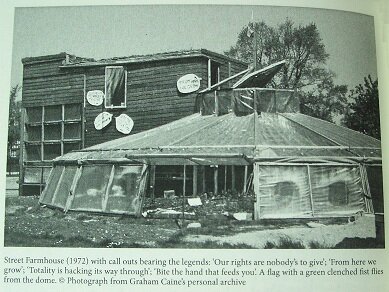Caine’s Eco-House as a Remote “Island” in a Temporal Archipelagos
· Is the idea of the eco house a liberation from the capitalistic social fabric or is it possessed with an element of limitation?
· The utopian ideal presupposes to take full responsibility. How ready are we to inhabit the eco house of the future?
Over the last fifty years our lives encountered numerous changes. The visual network that we yet perceived gradually started to be informed by “non existing” virtual ones that interconnected some parts of our sensed world, but at the same time separated others. As a result, technology was the main infrastructure that challenged the way we lived and through its evolution, it challenged the way our living was ordered as well. That evolution of technology may be present in the built environment, manifested in the striking skyscrapers between the east and the west, but the majority of people is still excluded from its implementation. Hence, the technology of tomorrow is being used to sustain the buildings of the past while we are still trying to persuade ourselves that the eco house of today is a postcard from the near future.
The new, the unique or the absurd presupposes an exploration out of your comfort zone and thus had always been holding a reserve of action. Projects like Archigram’s Plug in City, Fuller’s Geodesic Dome or Superstudio’s Continuous Monument all “understood graphic space as significant in and of itself while presenting a different trajectory—not just for drawing but for imagining architecture, simultaneously setting up alternative architectural propositions.”[1] All these projects had something in common. They were imaged based and thus, despite no intention of ever getting build. Through the medium of the image they managed to sell a desire. Who would possibly want an ecological house when in ten years’ time he may be living in the clouds?
Changes need a proposal, a scenario or at least something desirable. In an era of abundance, the common desire is to exploit the ungrasped. Hence, the restrictions posed by the eco house were mainly seen as a set of limitations towards a condition we were not willing to escapade. That been said, the idea of the eco house laid the foundations in the process of revolutionizing “a system of cyclical interdependencies that raised an alternative understanding of materiality. Caine’s experiments signaled a shift from mechanical devices to soft material structures.”[2][Figure 1] However, as Kallipoliti suggests, it is essential to perceive the eco-house through the same scope that we perceived the ambitious architectural paper projects of that time, a manifestation of social concern. Like doing so, the eco-house stops acting just as a glaring whim to the dominant idiosyncrasy and enables the reader to interpret it as a “spatial tool for social form propelled by scientific investigations, rather than as a project fostering technological supremacy.”[3]
Many conclusion can be drawn from the Eco-House. However, no one can deny the uniqueness of Caine’s approach and programmatic use. He utilized the idea of “paper architecture” by introducing the notion of temporality along the way, enabling the scheme to grow rather than be constructed. His research and the way he evolved the house became an integral part of the same system he inhabited, an assembly of interlocking parts that produce a new type of life form, rejecting and reimagining the basic principles upon which the notion of shelter has been based throughout the centuries. [Figure 2]
There is no doubt that the Eco-House would have never worked or even developed to a self-sustained level. It true significance however lays in the way this project could be utilized in the process of learning from the past to inform our future. Caine did not settle for the idea of just forming a new material but rather he pursued the “transference and migration of properties from one substance to another and all the intermediate stages of a productive cycle.”[4] That pioneer vision of his then marks this project a resemblance to Archigram’s pictorial Plug in City. What makes his project unique however is simply that it was built.
[1] http://www.metropolismag.com/architecture/architecture-enters-age-post-digital-drawing/
[2] L. Kallipoliti. “From Shit to Food: Graham Caine’s Eco-House in South London, 1972-1975” in Buildings
and Landscapes: The Journal of the Vernacular Architectural Forum 19/1 (Spring 2012): 94
[3] ibid 89
[4] Ibid 104

